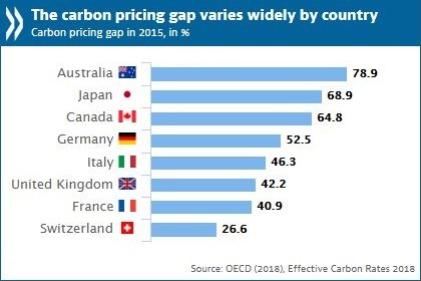Governments need to raise carbon prices much faster if they are to meet their commitments on cutting emissions and slowing the pace of climate change under the Paris Agreement, according to a new OECD report.

The report, titled: “Effective Carbon Rates 2018: Pricing Carbon Emissions through Taxes and Emissions Trading”, presents new data on taxes and tradeable permits for carbon emissions in 42 OECD and G20 countries accounting for around 80% of global emissions. It finds that today’s carbon prices – while slowly rising – are still too low to have a significant impact on curbing climate change.
The report shows that the carbon pricing gap – which compares actual carbon prices and real climate costs, estimated at EUR 30 per tonne of CO2 – was 76.5% in 2018. This compares favourably with the 83% carbon gap reported in 2012 and the 79.5% gap in 2015, but it is still insufficient. At the current pace of decline, carbon prices will only meet real costs in 2095. Much faster action is needed to incentivise companies to innovate and compete to bring about a low-carbon economy and to stimulate households to adopt low-carbon lifestyles.
“The gulf between today’s carbon prices and the actual cost of emissions to our planet is unacceptable,” said OECD Secretary-General, Angel Gurría. “Pricing carbon correctly is a concrete and cost-effective way to slow climate change. We are wasting an opportunity to steer our economies along a low-carbon growth path and losing precious time with every day that passes.”
The report measures carbon prices using the Effective Carbon Rate, which is the sum of three components: specific taxes on fossil fuels, carbon taxes and prices of tradeable emission permits. All three instruments increase the price of high-carbon relative to low- and zero-carbon fuels, encouraging energy users to go for low- or zero-carbon options.
The vast majority of emissions in industry and in the residential and commercial sector are entirely unpriced, the report finds. The carbon pricing gap is lowest for road transport (21% against the EUR 30 benchmark) and highest for industry (91%). The gap is over 80% in the electricity and the residential and commercial sectors.
Country analysis on 2015 carbon prices shows large variations, with carbon pricing gaps ranging from as low as 27% in Switzerland to above 90% in some emerging economies. France, India, Korea, Mexico and the United Kingdom substantially reduced their carbon pricing gaps between 2012 and 2015. Yet, still only 12 of the 42 countries studied had pricing gaps of below 50% in 2015.
New carbon pricing initiatives in some countries, such as China’s emissions trading scheme and renewed efforts in Canada and France to price carbon, could significantly reduce these gaps. The carbon-intensity of GDP is usually lower in countries with lower carbon pricing gaps.
The report rates emission trading as an effective way to price emissions, providing permit prices are stable at realistically high levels. Taxes have the advantage of simple administration, especially if grafted onto existing tax regimes. Revenue-neutral reforms can enable other taxes to be cut or carbon pricing can facilitate domestic revenue mobilisation.
